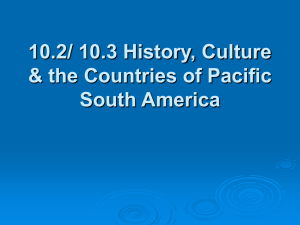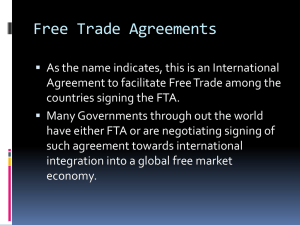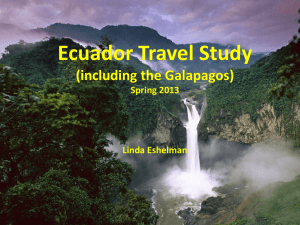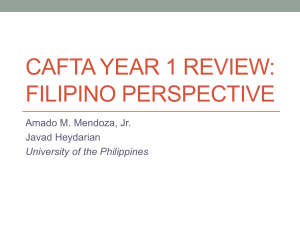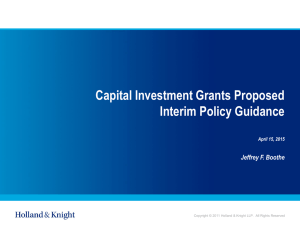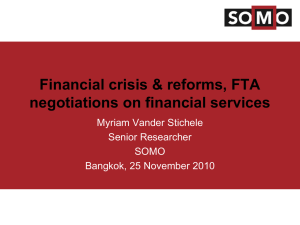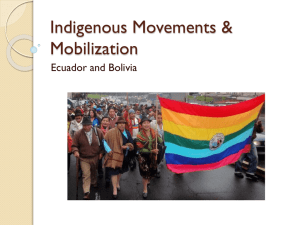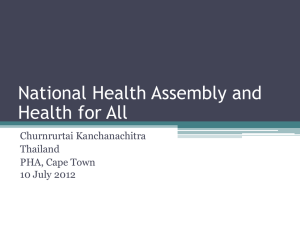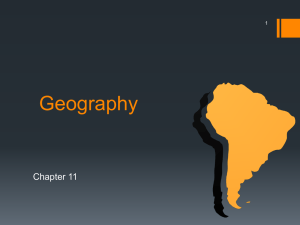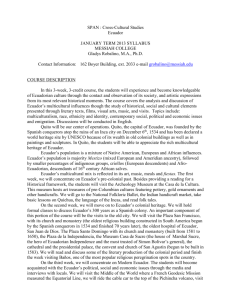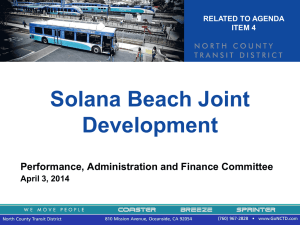EU - Andean Community Free Trade Agreement
advertisement
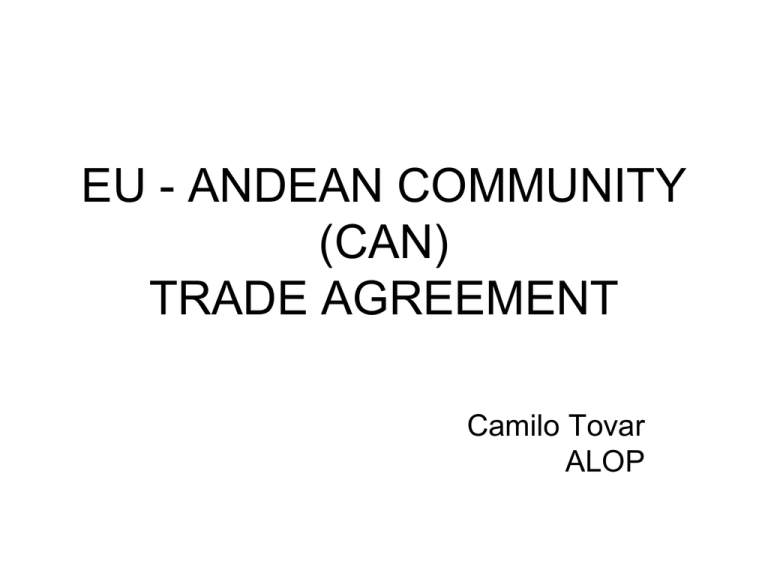
EU - ANDEAN COMMUNITY (CAN) TRADE AGREEMENT Camilo Tovar ALOP CAN Political Context Colombia - Perú Ecuador - Bolivia • Uribe 2002 • Garcia 2006 • Affirm neoliberal development model • Shrink State – market driven development: deregulation, privatisation, FTA, competitivity • Social conflict: authoritarism (Bagua , Minga, etc...) • Evo Morales 2006 • Correa 2007 • Constitutional processes rupture with neoliberal • Strengthen State – regulate market: nationalisation, regional, complementarity • Space and role of social movement Differentiation Different views on development Different strategies of international insertion • FTAA fails US FTA with CAN: – Colombia and Perú signed 2006 – Ecuador and Bolvia pull out (election flag) – Venezuela pulls out of CAN (2006 – Crisis) • Tense relations: Colombia vs. Ecuador Perú vs. Bolivia EU Political Context • 2004 Enlargement + EU Constitution Lisbon Treaty : LA less priority • Barroso COM 2004 Lisbon Agenda Growth and jobs: internal + external market • Global Europe 2006 (Mandelson) Competitiveness + business driven New generation of RTAs/FTAs Raw materials initiative 2008 (key priority) EU POLITICAL COMPASS 2008 Eastern block fast free market approach, slow social rights Western block expansion of neoliberal economics, erosion of some social policies Additional “pull factors” • Doha Development Round (WTO) – 2001 Talks collapse Cancun 2003 – 2005 Deadline missed (Hong Kong) extend to end 2006: missed 2008 Geneva: collapse • EU loosing market share - emerging economies (China) + US FTA • EU regional approach to FTAs EU - ANDEAN COMMUNITY (CAN) TRADE AGREEMENT • 1st EU-CAN Coop Agreement 1983 1993 • 2003 Political Dialogue and Coop Agreement • 2004 EU-LAC Summit EU: wait for FTA – EU evaluation of CAN economic integration • 2006: EU-LAC Summit - Crisis CAN (Venezuela) • June 2007: CAN Summit Tarija – Andean Differences Decision 667 (framework) • July 2007: Agreed modalities for negotiation EU “marca la cancha” • EU format: 3 pillars + region to region • Trade: classic FTA format (WTO plus) • Objectives: Strength regional integration – Social cohesion Sust. Development – Free trade • Asymmetries: “when possible” – SDT for CAN mechanism: ≠ speed liberal. • CAN Consensus base for negotiation – Possibility of veto (block proposals) Regional Negotiations • Complex negotiation process for CAN – 1st intra-CAN negotiation position to EU • Bolivia: innovative proposals – WG asymmetries and SDT for all agreement – No “across the board” national treatment – No further IPR TRIPS – Development benchmarks • COL + PE: accept but not commit • EU: “accept” but dangerous precedent • Challenge: new architecture + technical . • • • • • • • Sept 2007 – April 2008: 3 rounds Ecuador: low profile Quito Bolivia/Ecuador: ≠ FTA – regional integrat. Node: position on biodiversity and IPR CAN Summit Oct 2008 no solution Peru/Colombia: bilateral FTA (not new) 2009: EU propose Multiparty Trade Agree: – Only trade, ± bilateral regional long term Multiparty Trade Agreement • Ecuador: yes.. but Agreement for Development • Bolivia: Out • Speedy negotiation: 2009 – 2010: 8 rounds – EU aggresive: US FTA Plus Plus – Col/Peru: accepting conditions • Ecuador complex position: – No clear space for alternatives – Correa mandate NO FTA – Banana issue: heavy weight . • July 2009 Ecuador pulls out: – EU comply with WTO rulings on Banana – Include Polit. Dialogue and Coop • EU-LAC Summit May 2010: – Conclude, ambitious FTA EU-Col/Perú – Defines scenario for Ecuador and Bolivia • Ahead: – ratification process Col/Perú – Ecuador?? Conclusions • Regional integration further crisis • EU: satisfied FTA as they wanted • Col/Perú: re-affirm dev. Model – Raw materials export-led model (extractive) – Open services, public procurement and IPR – Erosion of State policy space – Static, long term – Investment • Ecu/Bol: struggle for alternatives
